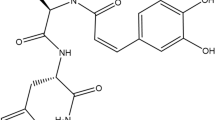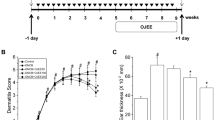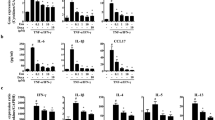Abstract
Chrysanthemum boreale (CB) has diverse properties including anti-inflammatory and anti-tumor effects. Atopic dermatitis (AD) is a chronic inflammatory skin disease, and many attempts have been made to overcome it. However, the effects of CB flower essential oil (CBFEO) on AD has not been determined. This study investigated the potential effect of CBFEO on AD-related pathological events using in vitro and in vivo tests and predicted its related mechanism. CBFEO effects were tested using tumor necrosis factor-α (TNF-α)-treated human keratinocytes (HaCaT cells) and IgE-sensitized RBL-2H3 mast cells in vitro and 2,4-dinitrochlorobenzene (DNCB)-induced AD-like mice in vivo. Proteins were analyzed by immunoprecipitation, immunoblotting, or immunohistochemistry. β-Hexosaminidase and histamine levels were measured by ELISA. Skin lesions were assessed using SCORAD scores. CBFEO reduced histamine and β-hexosaminidase released from mast cells. It also attenuated SNARE (soluble N-ethylmaleimide-sensitive factor activating protein receptor) protein VAMP8 expression and binding of VAMP8 to SNAP23 and syntaxin 4 to SNAP23 in mast cells. In addition, CBFEO inhibited the down-regulation of skin barrier-related proteins (filaggrin and loricrin) by TNF-α in keratinocytes. Application of CBFEO to AD-like skin lesions in DNCB mouse model of AD reduced the severity of dermatitis lesions and the expression levels of filaggrin and loricrin in lesioned skin tissues. These findings suggest that CBFEO inhibits AD-like skin lesions in mice probably by interfering with the SNARE protein-associated mast cell degranulation and by enhancing the expression of skin barrier-related proteins. Therefore, CBFEO may be a potential functional material for AD treatment.
Graphical abstract








Similar content being viewed by others
References
Akdis CA, Akdis M, Bieber T, Bindslev-Jensen C, Boguniewicz M, Eigenmann P et al (2006) Diagnosis and treatment of atopic dermatitis in children and adults: European academy of allergology and clinical immunology/American academy of allergy, asthma and immunology/PRACTALL consensus report. J Allergy Clin Immunol 118:152–169. https://doi.org/10.1016/j.jaci.2006.03.045
Andrew D, Craig AD (2001) Spinothalamic lamina I neurons selectively sensitive to histamine: a central neural pathway for itch. Nat Neurosci 4:72–77. https://doi.org/10.1038/82924
Bakkali F, Averbeck S, Averbeck D, Idaomar M (2008) Biological effects of essential oils– a review. Food Chem Toxicol 46:446–475. https://doi.org/10.1016/j.fct.2007.09.106
Candi E, Schmidt R, Melino G (2005) The cornified envelope: a model of cell death in the skin. Nat Rev Mol Cell Biol 6:328–430. https://doi.org/10.1038/nrm1619
Castle JD, Guo Z, Liu L (2002) Function of the t-SNARE SNAP-23 and secretory carrier membrane proteins (SCAMPs) in exocytosis in mast cells. Mol Immunol 38:1337–1340. https://doi.org/10.1016/S0161-5890(02)00084-6
Charles DJ, Simon JE (1990) Comparison of extraction methods for the rapid determination of essential oil content and composition of Basil. J Am Soc Hortic Sci 115:458–462. https://doi.org/10.21273/JASHS.115.3.458
Cho K, Parveen A, Kang MC, Subedi L, Lee JH, Park SY et al (2018) Pyrus ussuriensis Maxim. leaves extract ameliorates DNCB-induced atopic dermatitis-like symptoms in NC/Nga mice. Phytomedicine 48:76–83. https://doi.org/10.1016/j.phymed.2018.05.006
Fan HJ, Xie ZP, Lu ZW, Tan ZB, Bi YM, Xie LP et al (2018) Anti-inflammatory and immune response regulation of Si-Ni-San in 2,4-dinitrochlorobenzene-induced atopic dermatitis-like skin dysfunction. J Ethnopharmacol 222:1–10. https://doi.org/10.1016/j.jep.2018.04.032
Gschwandtner M, Mildner M, Mlitz V, Gruber F, Eckhart L, Werfel T et al (2013) Histamine suppresses epidermal keratinocyte differentiation and impairs skin barrier function in a human skin model. Allergy 68:37–47. https://doi.org/10.1111/all.12051
Gutowska-Owsiak D, Ogg GS (2013) Cytokine regulation of the epidermal barrier. Clin Exp Allergy 43:586–598. https://doi.org/10.1111/cea.12023
Guttman-Yassky E, Suárez-Fariñas M, Chiricozzi A, Nograles KE, Shemer A, Fuentes-Duculan J et al (2009) Broad defects in epidermal cornification in atopic dermatitis identified through genomic analysis. J Allergy Clin Immunol 124:1235-1244.e58. https://doi.org/10.1016/j.jaci.2009.09.031
Hänel KH, Cornelissen C, Lüscher B, Baron JM (2013) Cytokines and the skin barrier. Int J Mol Sci 14:6720–6745. https://doi.org/10.3390/ijms14046720
Hoang TK, Wang Y, Hwang YJ, Lim JH (2020) Analysis of the morphological characteristics and karyomorphology of wild Chrysanthemum species in Korea. Hortic Environ Biotechnol 61:359–369. https://doi.org/10.1007/s13580-019-00222-9
Kalinin A, Marekov LN, Steinert PM (2001) Assembly of the epidermal cornified cell envelope. J Cell Sci 114(17):3069–3070
Khaliq G, Abbas HT, Ali I, Waseem M (2019) Aloe vera gel enriched with garlic essential oil effectively controls anthracnose disease and maintains postharvest quality of banana fruit during storage. Hortic Environ Biotechnol 60:659–669. https://doi.org/10.1007/s13580-019-00159-z
Kim KJ, Kim YH, Yu HH, Jeong SI, Cha JD, Kil BS et al (2003) Antibacterial activity and chemical composition of essential oil of Chrysanthemum boreale. Planta Med 69:274–277. https://doi.org/10.1055/s-2003-38479
Kim BE, Leung DY (2012) Epidermal barrier in atopic dermatitis. Allergy Asthma Immunol Res 4:12–16. https://doi.org/10.4168/aair.2012.4.1.12
Kim DY, Won KJ, Yoon MS, Hwang DI, Yoon SW, Park JH et al (2015a) Chrysanthemum boreale Makino essential oil induces keratinocyte proliferation and skin regeneration. Nat Prod Res 29:562–564. https://doi.org/10.1080/14786419.2014.952231
Kim DY, Won KJ, Yoon MS, Yu HJ, Park JH, Kim B et al (2015b) Chrysanthemum boreale flower floral water inhibits platelet-derived growth factor-stimulated migration and proliferation in vascular smooth muscle cells. Pharm Biol 53:725–734. https://doi.org/10.3109/13880209.2014.941882
Kim DY, Won KJ, Hwang DI, Park SM, Kim B, Lee HM (2018) Chemical composition, antioxidant and anti-melanogenic activities of essential oils from Chrysanthemum boreale Makino at different harvesting stages. Chem Biodivers 15:e1700506. https://doi.org/10.1002/cbdv.201700506
MacDonald AJ, Haig DM, Bazin H, McGuigan AC, Moqbel R, Miller HR (1989) IgE-mediated release of rat mast cell protease II, beta-hexosaminidase and leukotriene C4 from cultured bone marrow-derived rat mast cells. Immunology 67:414–418
Malmersjö S, Di Palma S, Diao J, Lai Y, Pfuetzner RA, Wang AL et al (2016) Phosphorylation of residues inside the SNARE complex suppresses secretory vesicle fusion. EMBO J 35:1810–1821. https://doi.org/10.15252/embj.201694071
Mócsai G, Gáspár K, Nagy G, Irinyi B, Kapitány A, Bíró T et al (2014) Severe skin inflammation and filaggrin mutation similarly alter the skin barrier in patients with atopic dermatitis. Br J Dermatol 170:617–624. https://doi.org/10.1111/bjd.12743
Nakamura T, Yoshida N, Yamanoi Y, Honryo A, Tomita H, Kuwabara H, Kojima Y (2020) Eucalyptus oil reduces allergic reactions and suppresses mast cell degranulation by downregulating IgE-FcεRI signalling. Sci Rep 10:20940. https://doi.org/10.1038/s41598-020-77039-5
Nguyen TK, Ha STT, Kim JH (2020) Analysis of chrysanthemum genetic diversity by genotyping-by-sequencing. Hortic Environ Biotechnol 61:903–913. https://doi.org/10.1007/s13580-019-00222-9
Noh M, Yeo H, Ko J, Kim HK, Lee CH (2010) MAP17 is associated with the T-helper cell cytokine-induced down-regulation of filaggrin transcription in human keratinocytes. Exp Dermatol 19:355–362. https://doi.org/10.1111/j.1600-0625.2009.00902.x
Nutten S (2015) Atopic dermatitis: global epidemiology and risk factors. Ann Nutr Metab 66(Suppl 1):8–16. https://doi.org/10.1159/000370220
Otsuka A, Doi H, Egawa G, Maekawa A, Fujita T, Nakamizo S et al (2014) Possible new therapeutic strategy to regulate atopic dermatitis through upregulating filaggrin expression. J Allergy Clin Immunol 133:139–146. https://doi.org/10.1016/j.jaci.2013.07.027
Park HJ, Jang YJ, Yim JH, Lee HK, Pyo S (2016) Ramalin isolated from Ramalina Terebrata attenuates atopic dermatitis-like skin lesions in Balb/c mice and cutaneous immune responses in keratinocytes and mast cells. Phytother Res 30:1978–1987. https://doi.org/10.1002/ptr.5703
Puri N, Kruhlak MJ, Whiteheart SW, Roche PA (2003) Mast cell degranulation requires N-ethylmaleimide-sensitive factor-mediated SNARE disassembly. J Immunol 171:5345–5352. https://doi.org/10.4049/jimmunol.171.10.5345
Steinhoff M, Steinhoff A, Homey B, Luger TA, Schneider SW (2006) Role of vasculature in atopic dermatitis. J Allergy Clin Immunol 118:190–197. https://doi.org/10.1016/j.jaci.2006.04.025
Tang F, Chen F, Ling X, Huang Y, Zheng X, Tang Q et al (2015) Inhibitory effect of methyleugenol on IgE-mediated allergic inflammation in RBL-2H3 cells. Mediators Inflamm 2015:463530. https://doi.org/10.1155/2015/463530
Tyagi S, Jung JA, Kim JS, Won SY (2020) A comparative analysis of the complete chloroplast genomes of three Chrysanthemum boreale strains. PeerJ 8:e9448. https://doi.org/10.7717/peerj.9448
Udkoff J, Waldman A, Ahluwalia J, Borok J, Eichenfield LF (2017) Current and emerging topical therapies for atopic dermatitis. Clin Dermatol 35:375–382. https://doi.org/10.1016/j.clindermatol.2017.03.010
Van den Bogaard EH, Bergboer JG, Vonk-Bergers M, van Vlijmen-Willems IM, Hato SV, van der Valk PG et al (2013) Coal tar induces AHR-dependent skin barrier repair in atopic dermatitis. J Clin Invest 123:917–927. https://doi.org/10.1172/JCI65642
Wang Y, Cao S, Yu K, Yang F, Yu X, Zhai Y, Wu C, Xu Y (2019) Integrating tacrolimus into eutectic oil-based microemulsion for atopic dermatitis: simultaneously enhancing percutaneous delivery and treatment efficacy with relieving side effects. Int J Nanomedicine 14:5849–5863. https://doi.org/10.2147/IJN.S212260
Weidinger S, Novak N (2016) Atopic dermatitis. Lancet 387:1109–1122. https://doi.org/10.1016/S0140-6736(15)00149-X
Woska JR Jr, Gillespie ME (2011) Small-interfering RNA-mediated identification and regulation of the ternary SNARE complex mediating RBL-2H3 mast cell degranulation. Scand J Immunol 73:8–17. https://doi.org/10.1111/j.1365-3083.2010.02471.x
Woska JR Jr, Gillespie ME (2012) SNARE complex-mediated degranulation in mast cells. J Cell Mol Med 16:649–656. https://doi.org/10.1111/j.1582-4934.2011.01443.x
Wu Z, Thiyagarajan S, O’Shaughnessy B, Karatekin E (2017) Regulation of exocytotic fusion pores by SNARE protein transmembrane domains. Front Mol Neurosci 10:315. https://doi.org/10.3389/fnmol.2017.00315
Yan W, Jung JA, Lim KB, Cabahug RAM, Hwang YJ (2019) Cytogenetic studies of chrysanthemum: a review. Flower Res J 27:242–253. https://doi.org/10.11623/frj.2019.27.4.02
Yang Y, Kong B, Jung Y, Park JB, Oh JM, Hwang J et al (2018) Soluble N-ethylmaleimide-sensitive factor attachment protein receptor-derived peptides for regulation of mast cell degranulation. Front Immunol 9:725. https://doi.org/10.3389/fimmu.2018.00725
Yang G, Lee K, An DG, Lee MH, Ham IH, Choi HY (2012) Effect of Chrysanthemi borealis flos on atopic dermatitis induced by 1-chloro 2,4-dinitrobenzene in NC/Nga mouse. Immunopharmacol Immunotoxicol 34:413–418. https://doi.org/10.3109/08923973.2011.613401
Yang WS, Lee SR, Jeong YJ, Park DW, Cho YM, Joo HM et al (2016) Antiallergic activity of ethanol extracts of Arctium lappa L. undried roots and its active compound, oleamide, in regulating FcεRI-mediated and MAPK signaling in RBL-2H3 cells. J Agric Food Chem 64:3564–3573. https://doi.org/10.1021/acs.jafc.6b00425
Yun Y, Kim K, Choi I, Ko SG (2014) Topical herbal application in the management of atopic dermatitis: a review of animal studies. Mediators Inflamm 2014:752103. https://doi.org/10.1155/2014/752103
Acknowledgements
This study was carried out with the support of R&D Program for Forestry Technology (Project No. 2016016B10-1919-AB02 and 2020190B10-2122-BA01) provided by Korea Forest Service (Korea Forestry Promotion Institute).
Author information
Authors and Affiliations
Contributions
HML and DYK projected and designed the study. DYK, DIH and SYL performed experiments and data acquisition. DYK, DIH, SYL and IHC prepared figures. HML, DYK, BK and KJW analyzed and interpreted data. DYK and KJW drafted the manuscript. HML and KJW edited and reviewed the manuscript. All authors have read and approved the final manuscript.
Corresponding author
Ethics declarations
Conflict of interests
The authors declare no conflict of interest.
Statement on the welfare of animals
All animal experiments and procedures in this study were conducted in compliance with the Guide for the Care and Use of Laboratory Animals published by the US National Institutes of Health (NIH publication No. 85–23, revised 2011) and were approved by the Animal Subjects Committee following Institutional Guidelines of Konkuk University (South Korea) (Approval number: KU18203) and conducted according to institutional guidelines.
Additional information
Communicated by Sanghyun Lee.
Publisher's Note
Springer Nature remains neutral with regard to jurisdictional claims in published maps and institutional affiliations.
Supplementary Information
Below is the link to the electronic supplementary material.
Rights and permissions
About this article
Cite this article
Kim, D.Y., Won, KJ., Hwang, D.I. et al. Essential oil from Chrysanthemum boreale flowers modulates SNARE protein-linked mast cell response and skin barrier proteins and ameliorates atopic dermatitis-like lesions in mice. Hortic. Environ. Biotechnol. 63, 287–298 (2022). https://doi.org/10.1007/s13580-021-00393-4
Received:
Revised:
Accepted:
Published:
Issue Date:
DOI: https://doi.org/10.1007/s13580-021-00393-4




